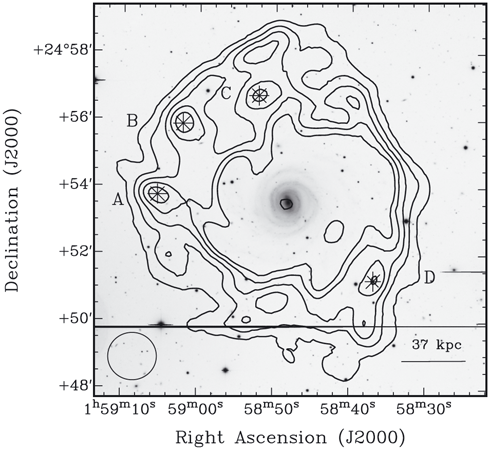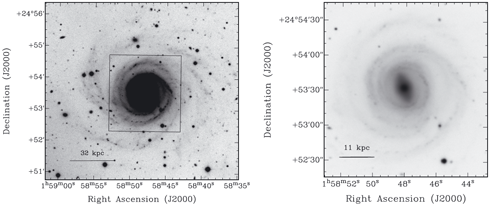 CAUP Researchers: António Portas, Mercedes E. Filho NGC765 - A disturbed HI giant, We present HI spectral line and radio-continuum Very Large Array (VLA) data of the galaxy NGC 765, complemented by optical and Chandra X-ray maps. NGC 765 has the largest HI-to-optical ratio known to date of any spiral galaxy and one of the largest known HI discs in absolute size with a diameter of 240 kpc measured at a surface density of 2 × 1019 atom cm-2. We derive a total HI mass of MHI = 4.7 × 1010M☉, a dynamical mass of Mdyn ~ 5.1 × 1011M☉ and an HI mass-to-luminosity ratio of MHI/LB = 1.6, making it the nearest and largest 'crouching giant'. Optical images reveal evidence of a central bar with tightly wound low surface brightness spiral arms extending from it. Radio-continuum (L1.4 GHz = 1.3 × 1021 WHz-1) and X-ray (LX ≈ 1.7 × 1040 erg s-1) emission is found to coincide with the optical core of the galaxy, compatible with nuclear activity powered by a low-luminosity active galactic nucleus. We may be dealing with a galaxy that has retained in its current morphology traces of its formation history. In fact, it may still be undergoing some accretion, as evidenced by the presence of HI clumps the size (<10 kpc) and mass (108-109M☉) of small (dIrr) galaxies in the outskirts of its HI disc and by the presence of two similarly sized companions.
Several questions regarding the formation and evolution of galaxies still lure among the extreme diversity of galaxies' morphologies and evolutionary states we observe throughout the Universe. Among these, some of the still outstanding questions regard the formation of members of a category of low surface brightness (LSB) galaxies, known as 'crouching giants' or 'Malin 1 cousins'. These galaxies, named after the prototypical Malin 1, present high fractions of H I gas, low central surface brightnesses and large scalelengths and are, in fact, among the largest spirals known in the Universe. With this work, we studied NGC 765, a galaxy that resembles Malin 1 but is located at a distance 4-5 times shorter, with H I, radio-continuum, optical and X-ray data. NGC 765 is classified as a SAB(rb)bc galaxy, presents the signature of a central bar and has an extrapolated disc central surface brightness of 22.27 in the B band. The detection of [N II], [S I] and [O I] lines indicate that NGC 765 may have a low-luminosity active galactic nucleus (AGN). Assuming H0=72 km s-1 Mpc-1, this galaxy is located at a distance of 72 Mpc and seems to be part of a group of 14 galaxies. The radio data was obtained from public domain archives of NRAO Very Large Array D observations performed in 1998 (Figure 1), the optical data was obtained in 2009 with the Wide Field Camera on the Isaac Newton Telescope (Figures 1 and 2) and the X-ray data was obtained from archive Chandra observations, performed in 2007 with ACIS-S. From the observations, we estimate an H I mass of 4.67 x 1010 M☉, which results in a mass-to-luminosity ratio of ∼1.6. Two companion galaxies were also detected in our field: NGC 765a (a previously unknown galaxy, discovered in this work) and UGC 1453. NGC 765 presents an extended H I distribution with 240 kpc, whereas the stellar disc, with a scalelength of 7.8 kpc, could be detected only up to ∼50 kpc from the nucleus. Thus, this galaxy presents an H I-to-optical ratio of 15, which is considerably larger than what was found for other giant LSB galaxies. Nevertheless, there is no detected star formation in the outer disk, indicating that this gas is below the threshold for igniting star formation, which is in accordance with the gas densities we measured. The outer disc of NGC 765 is asymmetrical and slightly warped and is populated by 4 compact H I regions, which present typical masses of about 109 M☉; these regions present similar properties to those of the companion galaxies detected in our field and are possible remnants of past merger events. The rotation curves show a steep increase within a radius of ~40 arcsec and a flat rotation curve beyond ∼100 arcsec, with a velocity of about 160 km s-1. Using the thin disk approximation, we derived a dynamical mass of 5.1 x 1011 M☉. The detection of a central X-ray source and a low-luminosity radio-continuum source, along with the [N II], [S I] and [O I] nuclear emission lines, provides strong evidence for the presence of a low-luminosity AGN. The observed H I clumps, the large size of the H I disk, the shape of the velocity field and the observed disk distortions are all compatible with a scenario of past accretion of a number of small companions. This highlighted paper was written as part of the Ph.D. project of António M. Portas who, thus, provided the major contribution to this work. |























